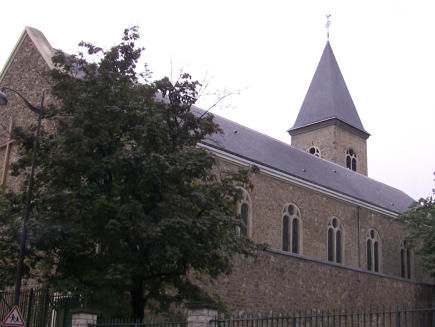



ORGANS OF PARIS © 2025 Vincent Hildebrandt HOME ALL ORGANS



The church
In Paris, the Montmartre district had plaster
quarries, which were widely used in the 19th
century. Around 1860, with the increase in
population, the need for a new place of worship was
felt. But the city council rejected the idea of a new
church. In 1891, the archdiocese expanded the
former Chapel of Works, located within a hospital
and served by the Augustinian sisters.
The chapel was erected as a parish church in 1907
under the name of St. Genevieve. In 1908, it was
expanded again.
The shrine is built of grindstone and cement. The
interior is beautifully decorated with arched arches
in the middle of a beautiful whiteness, typical of the
religious art of the early 20th century.

1890 - Cavaillé-Coll (1)
1909 - Mutin (3a)
1955 - Müller (6)
1981 - Barbéris (6)
2016 - Bernard Cogez (5)
2025 - Yves Koenig (3a)
III/22 - traction mécanique
composition
C4
The instrument, originally built for the Berlioz Theatre in Paris
(Rue de Clichy), was designed by Aristide Cavaillé-Coll in 1890.
In 1909, it was transferred to St. Genevieve's Church, and the
console was then modified by Charles Mutin.
In 1955, Erwin Muller transformed the Octavin of the Grand
Organ into a Doublette. In 1981, Barbéris was commissioned
to carry out work on mechanics.
In 2016, the organ was restored partially by Bernard Cogez.
In 2025, an overhaul by Yves Koenig.
In 2025, restoration work by Yves Koenig:
Mutin’s intervention left no element untouched. The case,
currently painted in faux oak, the windchests, and even the
pipework were modified.
The organ comprises twenty-two stops distributed across
three manuals and pedalboard. Both the Positif and Récit
divisions are expressive, and all windchests are slider chests.
This organ must regain its original coherence, lost for over a
century. The internal layout will be redesigned to ensure a
clear and simple mechanical action. All key and stop actions
will be rebuilt following the methods of Cavaillé-Coll. Finally,
the instrument’s tonal palette will be enriched with a 16’
Quintaton, an 8’ Clarinet, a 4’ Clairon, and a 2’ Octavin.
The organ will be fully reassembled and reinstalled on its
gallery in early 2026.
Organiste titulaire
Fabre Guin
Masses with organ
Saturday, 6:30 PM, Sunday, 10:30 AM
Videos
-
Photo: Jeroen de Haan
The organs of Paris

ORGANS OF PARIS © 2025 Vincent Hildebrandt ALL ORGANS
C4
The instrument, originally built for the Berlioz Theatre in
Paris (Rue de Clichy), was designed by Aristide Cavaillé-Coll in
1890.
In 1909, it was transferred to St. Genevieve's Church, and the
console was then modified by Charles Mutin.
In 1955, Erwin Muller transformed the Octavin of the Grand
Organ into a Doublette. In 1981, Barbéris was commissioned
to carry out work on mechanics.
In 2016, the organ was restored partially by Bernard Cogez.
In 2025, an overhaul by Yves Koenig.
In 2025, restoration work by Yves Koenig:
Mutin’s intervention left no element untouched. The case,
currently painted in faux oak, the windchests, and even the
pipework were modified.
The organ comprises twenty-two stops distributed across
three manuals and pedalboard. Both the Positif and Récit
divisions are expressive, and all windchests are slider chests.
This organ must regain its original coherence, lost for over a
century. The internal layout will be redesigned to ensure a
clear and simple mechanical action. All key and stop actions
will be rebuilt following the methods of Cavaillé-Coll. Finally,
the instrument’s tonal palette will be enriched with a 16’
Quintaton, an 8’ Clarinet, a 4’ Clairon, and a 2’ Octavin.
The organ will be fully reassembled and reinstalled on its
gallery in early 2026.
1890 - Cavaillé-Coll (1)
1909 - Mutin (3a)
1955 - Müller (6)
1981 - Barbéris (6)
2016 - Bernard Cogez (5)
2025 - Yves Koenig (3a)
III/22 - traction mécanique
composition
Organiste titulaire
Fabre Guin
Masses with organ
Saturday, 6:30 PM, Sunday, 10:30 AM
Videos
-
Photo: Jeroen de Haan























